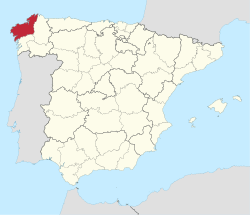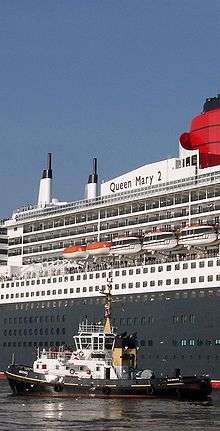Province of A Coruña
| A Coruña | |
|---|---|
| Province | |
 Location of the Province of A Coruña within Spain | |
| Coordinates: 43°22′N 8°24′W / 43.37°N 8.40°WCoordinates: 43°22′N 8°24′W / 43.37°N 8.40°W | |
| Country |
|
| Autonomous community | Galicia |
| Capital | A Coruña |
| Government | |
| • Body | Deputación da Coruña |
| • President | Diego Calvo Pouso (Popular Party) |
| Area | |
| • Total | 7,950 km2 (3,070 sq mi) |
| Area rank | 32nd |
| Population | |
| • Total | 1,139,121 |
| • Rank | 10th |
| • Density | 140/km2 (370/sq mi) |
| Demonym(s) | Coruñés (m), Coruñesa (f) |
| Postal code | 15--- |
| ISO 3166 code | ES-C |
| Parliament | 24 deputies (out of 75) |
| Congress | 9 deputies (out of 350) |
| Senate | 4 senators (out of 264) |
| Website | http://www.dicoruna.es/ |
The province of A Coruña (Galician: [a koˈɾuɲa]; Spanish: La Coruña [la koˈɾuɲa]; English: Corunna[1]) is the most North-western Atlantic-facing province of Spain, and one of the four provinces which constitute the autonomous community of Galicia. This province is surrounded by the Atlantic Ocean to the West and North, Pontevedra Province to the South and the Lugo Province to the East.
History

The history of this province starts at the end of the Middle Ages during the reign of the Catholic Monarchs of Spain. During those years this province was far smaller than today. This is because in the 1833 territorial division of Spain the entire Province of Betanzos together with half of the Mondoñedo were amalgamated into one single province with its capital city in A Coruña. That was going to be the beginning of a love hate relationship between the major cities caught in between: Ferrol, Santiago de Compostela and A Coruña. Due to this unusual situation, the dioceses of these parts of Galicia do not match any longer with the administrative divisions. In addition, the capital city of the province has never had a cathedral, but both Ferrol and Santiago de Compostela have one. The City of Santiago de Compostela is not the provincial capital, but has always been the capital of Galicia and historically a rival to Toledo for being the most important city in Spain ecclesiastically speaking.
Since 1833, the province has always been the one with the largest population and largest coast. Until the second half of the 20th century, this province was both the religious and cultural centre of the entire region. The University of Santiago de Compostela was the only university in North-western Spain until the arrival of democracy after the death of General Francisco Franco.
Population
| A Coruña Province Population c. 1787 | |||
|---|---|---|---|
| District | population | ||
| City of Coruña | 13,575 | ||
| City of Ferrol (Civilian Pop. Only) | 24,993 | ||
| Santiago de Compostela | 15,584 | ||
| Towns, Villages and Hamlets | c.229,123 | ||
| All the Province (Total): | 283,275 | ||
| (Ferrol - Urban History, 2004) | |||
| A Coruña Province Population c. 1833 | |||
|---|---|---|---|
| District | population | ||
| City of Coruña | 23,000 | ||
| City of Ferrol (Civilian Pop. Only) | 13,000 | ||
| Santiago de Compostela | 28,000 | ||
| Towns, Villages and Hamlets | c.233,000 | ||
| All the Province (Total): | c.297,000 | ||
| (U. P. Gazetteer By Th.Baldwin, 1847) | |||
| A Coruña Province Population c. 1900 | |||
|---|---|---|---|
| District | population | ||
| City of Coruña | 43,971 | ||
| City of Ferrol (Civilian Pop. Only) | 25,281 | ||
| Santiago de Compostela | 24,120 | ||
| Towns, Villages and Hamlets | 580,184 | ||
| All the Province (Total): | 653,556 | ||
| (Encyclopædia Britannica, 1911) s:User:Tim Starling/ScanSet PNG demo | |||
Main sights
The cathedral of Santiago de Compostela is the destination of the Way of St. James, a major historical pilgrimage route since the Middle Ages which still gathers thousands of pilgrims each year from all over the world.
Parks
- Atlantic Islands of Galicia National Park[2] is the only National Park in Galicia. It is shared between the Provinces of A Coruña and Pontevedra.
- The "Fragas" of the River Eume Natural Park extends itself throughout the Eume and Ferrol regions of Ferrolterra.
- The Dunes of Corrubedo Natural Park (Parque Natural das Dunas de Corrubedo e lagoas de Carregal e Vixán) is a beach park at the very end of the Barbanza Peninsula.
Transport
Airports and airfields
- Aeroporto da Lavacolla in Santiago de Compostela
- Aeroporto de Alvedro in the City of A Coruña
- Heliporto da Graña in the Naval Base of A Graña (Ferrolterra)
- Heliporto de Narón in Naron (Ferrolterra)
Railway
- Spanish National Railway Network Linking every major city: Ferrol, Betanzos, A Coruña and Santiago de Compostela
- Spanish Narrow-Gauge Railways Linking the City of Ferrol with different towns of Ferrol and Ortegal. This line is also known as Ferrol-Irun (Basque Country)
- Spanish High Speed Railway Network (AVE) Linking most major cities of the province with Lisbon and Madrid is under construction.
Economy
Ports
- A Coruña – Major Commercial Port – Costa da Morte
- Malpica – Fishing Port – Costa da Morte
- Camariñas – Fishing Port – Costa da Morte
- Fisterra – Fishing Port – Costa da Morte
- Ferrol – Major Commercial Ports (also: Military) – Rias altas
- Cariño – Fishing Port – Rias altas
- Espasante – Fishing Port – Rias altas
- Cedeira – Fishing Port – Rias altas
Sport
- Deportivo de La Coruña Spanish first division team from the City of A Coruña.
- Rácing de Ferrol Spanish Segunda Division team from the City of Ferrol.
- SD Compostela Spanish Tercera Division team from the City of Santiago de Compostela.
- Atlético Arteixo Spanish Segunda Division team from the Municipality of Arteixo.
- Bergantiños FC Spanish Tercera Division team from the Municipality of Carballo.
- SD Negreira Spanish Tercera Division team from the Municipality of Negreira.
- Autos Lobelle de Santiago FS Spanish División de Honor of Futsal team from the City of Santiago de Compostela.
See also
References
- ↑
 Chisholm, Hugh, ed. (1911). "Corunna". Encyclopædia Britannica. 7 (11th ed.). Cambridge University Press. p. 208.
Chisholm, Hugh, ed. (1911). "Corunna". Encyclopædia Britannica. 7 (11th ed.). Cambridge University Press. p. 208. - ↑ (Spanish) Atlantic Islands of Galicia National Park